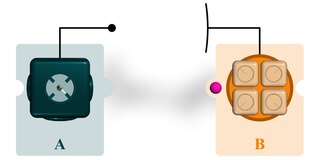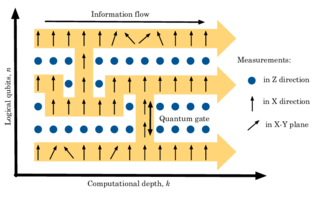
Quantum teleportation is a technique for transferring quantum information from a sender at one location to a receiver some distance away. While teleportation is commonly portrayed in science fiction as a means to transfer physical objects from one location to the next, quantum teleportation only transfers quantum information. The sender does not have to know the particular quantum state being transferred. Moreover, the location of the recipient can be unknown, but to complete the quantum teleportation, classical information needs to be sent from sender to receiver. Because classical information needs to be sent, quantum teleportation cannot occur faster than the speed of light.

In quantum computing, a qubit or quantum bit is a basic unit of quantum information—the quantum version of the classic binary bit physically realized with a two-state device. A qubit is a two-state quantum-mechanical system, one of the simplest quantum systems displaying the peculiarity of quantum mechanics. Examples include the spin of the electron in which the two levels can be taken as spin up and spin down; or the polarization of a single photon in which the two spin states can also be measured as horizontal and vertical linear polarization. In a classical system, a bit would have to be in one state or the other. However, quantum mechanics allows the qubit to be in a coherent superposition of multiple states simultaneously, a property that is fundamental to quantum mechanics and quantum computing.
Quantum error correction (QEC) is used in quantum computing to protect quantum information from errors due to decoherence and other quantum noise. Quantum error correction is theorised as essential to achieve fault tolerant quantum computing that can reduce the effects of noise on stored quantum information, faulty quantum gates, faulty quantum preparation, and faulty measurements. This would allow algorithms of greater circuit depth.

A trapped-ion quantum computer is one proposed approach to a large-scale quantum computer. Ions, or charged atomic particles, can be confined and suspended in free space using electromagnetic fields. Qubits are stored in stable electronic states of each ion, and quantum information can be transferred through the collective quantized motion of the ions in a shared trap. Lasers are applied to induce coupling between the qubit states or coupling between the internal qubit states and the external motional states.
A topological quantum computer is a theoretical quantum computer proposed by Russian-American physicist Alexei Kitaev in 1997. It employs quasiparticles in two-dimensional systems, called anyons, whose world lines pass around one another to form braids in a three-dimensional spacetime. These braids form the logic gates that make up the computer. The advantage of a quantum computer based on quantum braids over using trapped quantum particles is that the former is much more stable. Small, cumulative perturbations can cause quantum states to decohere and introduce errors in the computation, but such small perturbations do not change the braids' topological properties. This is like the effort required to cut a string and reattach the ends to form a different braid, as opposed to a ball bumping into a wall.
In quantum computing, the Gottesman–Knill theorem is a theoretical result by Daniel Gottesman and Emanuel Knill that states that stabilizer circuits, circuits that only consist of gates from the normalizer of the qubit Pauli group, also called Clifford group, can be perfectly simulated in polynomial time on a probabilistic classical computer. The Clifford group can be generated solely by using CNOT, Hadamard, and phase gate S; and therefore stabilizer circuits can be constructed using only these gates.
Quantum cloning is a process that takes an arbitrary, unknown quantum state and makes an exact copy without altering the original state in any way. Quantum cloning is forbidden by the laws of quantum mechanics as shown by the no cloning theorem, which states that there is no operation for cloning any arbitrary state perfectly. In Dirac notation, the process of quantum cloning is described by:

The one-way or measurement-based quantum computer (MBQC) is a method of quantum computing that first prepares an entangled resource state, usually a cluster state or graph state, then performs single qubit measurements on it. It is "one-way" because the resource state is destroyed by the measurements.
In quantum information and quantum computing, a cluster state is a type of highly entangled state of multiple qubits. Cluster states are generated in lattices of qubits with Ising type interactions. A cluster C is a connected subset of a d-dimensional lattice, and a cluster state is a pure state of the qubits located on C. They are different from other types of entangled states such as GHZ states or W states in that it is more difficult to eliminate quantum entanglement in the case of cluster states. Another way of thinking of cluster states is as a particular instance of graph states, where the underlying graph is a connected subset of a d-dimensional lattice. Cluster states are especially useful in the context of the one-way quantum computer. For a comprehensible introduction to the topic see.
In quantum computing, the threshold theorem states that a quantum computer with a physical error rate below a certain threshold can, through application of quantum error correction schemes, suppress the logical error rate to arbitrarily low levels. This shows that quantum computers can be made fault-tolerant, as an analogue to von Neumann's threshold theorem for classical computation. This result was proven by the groups of Dorit Aharanov and Michael Ben-Or; Emanuel Knill, Raymond Laflamme, and Wojciech Zurek; and Alexei Kitaev independently. These results built off a paper of Peter Shor, which proved a weaker version of the threshold theorem.
The toric code is a topological quantum error correcting code, and an example of a stabilizer code, defined on a two-dimensional spin lattice. It is the simplest and most well studied of the quantum double models. It is also the simplest example of topological order—Z2 topological order (first studied in the context of Z2 spin liquid in 1991). The toric code can also be considered to be a Z2 lattice gauge theory in a particular limit. It was introduced by Alexei Kitaev.
In quantum mechanics, the cat state, named after Schrödinger's cat, is a quantum state composed of two diametrically opposed conditions at the same time, such as the possibilities that a cat is alive and dead at the same time.
Linear optical quantum computing or linear optics quantum computation (LOQC), also photonic quantum computing (PQC), is a paradigm of quantum computation, allowing (under certain conditions, described below) universal quantum computation. LOQC uses photons as information carriers, mainly uses linear optical elements, or optical instruments (including reciprocal mirrors and waveplates) to process quantum information, and uses photon detectors and quantum memories to detect and store quantum information.
The KLM scheme or KLM protocol is an implementation of linear optical quantum computing (LOQC), developed in 2000 by Emanuel Knill, Raymond Laflamme, and Gerard J. Milburn. This protocol allows for the creation of universal quantum computers using solely linear optical tools. The KLM protocol uses linear optical elements, single-photon sources, and photon detectors as resources to construct a quantum computation scheme involving only ancilla resources, quantum teleportations, and error corrections.
In quantum computing, a qubit is a unit of information analogous to a bit in classical computing, but it is affected by quantum mechanical properties such as superposition and entanglement which allow qubits to be in some ways more powerful than classical bits for some tasks. Qubits are used in quantum circuits and quantum algorithms composed of quantum logic gates to solve computational problems, where they are used for input/output and intermediate computations.
Randomized benchmarking is an experimental method for measuring the average error rates of quantum computing hardware platforms. The protocol estimates the average error rates by implementing long sequences of randomly sampled quantum gate operations. Randomized benchmarking is the industry-standard protocol used by quantum hardware developers such as IBM and Google to test the performance of the quantum operations.
In quantum computing and quantum information theory, the Clifford gates are the elements of the Clifford group, a set of mathematical transformations which normalize the n-qubit Pauli group, i.e., map tensor products of Pauli matrices to tensor products of Pauli matrices through conjugation. The notion was introduced by Daniel Gottesman and is named after the mathematician William Kingdon Clifford. Quantum circuits that consist of only Clifford gates can be efficiently simulated with a classical computer due to the Gottesman–Knill theorem.
The Eastin–Knill theorem is a no-go theorem that states: "No quantum error correcting code can have a continuous symmetry which acts transversely on physical qubits". In other words, no quantum error correcting code can transversely implement a universal gate set, where a transversal logical gate is one that can be implemented on a logical qubit by the independent action of separate physical gates on corresponding physical qubits.
This glossary of quantum computing is a list of definitions of terms and concepts used in quantum computing, its sub-disciplines, and related fields.










